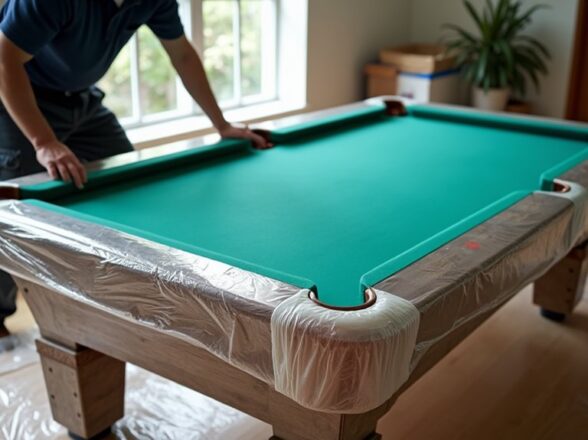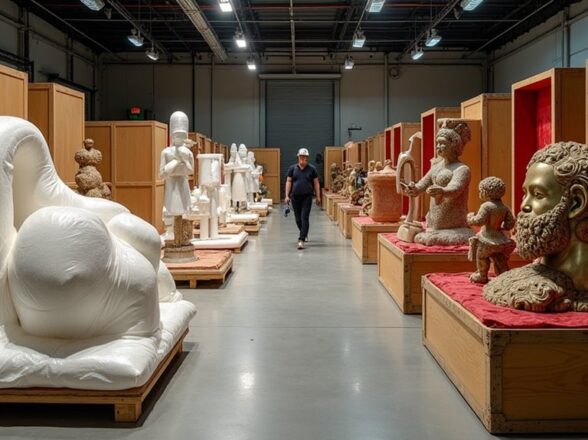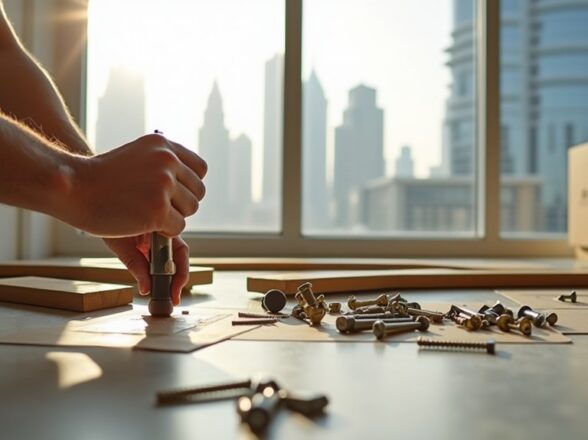How to Move Other Valuable Collections (Jewelry, Rare Books, Vintage Items)? Expert Moving Tips for High-Value Items

To move valuable collections like jewelry, rare books, and vintage items, start by creating a detailed inventory. Document each item's condition with photographs and receipts. When packing, use high-quality, acid-free materials. Wrap jewelry individually and pack rare books upright in sturdy boxes. Choose a reputable moving company that specializes in high-value items, guaranteeing they use climate-controlled vehicles. Insurance is essential; consider full value protection for adequate coverage. After moving, inspect items immediately and update your inventory. Following these tips will help you secure the safe transport of your valuable possessions while keeping them well-documented and protected.
Identifying High-Value Items

When it comes to identifying high-value items, how can you be certain you’re not overlooking something important? Start by listing valuable belongings worth $100 per pound or more. This includes jewelry, rare books, and vintage collectibles. Jewelry is vital due to its intrinsic value and risk of loss during transport. Rare books hold both monetary value and historical significance, while vintage items like retro furniture require careful handling to maintain their condition. Create a detailed inventory list for documentation and insurance purposes. Consider using protective packing techniques to safeguard these delicate items. If the task feels overwhelming, hiring professional movers and packers can help guarantee your high-value items are packed and transported safely. Additionally, it’s crucial to recognize that certain items, such as fine art, require specialized care and expertise during the moving process. For this reason, consider enlisting fine art moving services that are trained in handling and transporting artworks with precision. This level of professionalism ensures that your most prized possessions are not only kept safe but also arrive at their destination in perfect condition.
Packing Essentials for Valuable Collections
To guarantee your valuable collections are well-protected during a move, start by using high-quality, acid-free packing materials. Use bubble wrap and packing paper to shield fragile items from moisture and abrasion. Secure jewelry in padded boxes, wrapping each piece individually to avoid scratches. For rare books, pack them in specialized boxes that fit snugly and include cushioning materials to prevent movement. Vintage items need special care; custom crating works best for delicate pieces, and all hardware should be removed and stored in labeled bags. Clearly label boxes with "Fragile" and handling instructions like "Handle with care" and "This Side Up" to make sure movers treat your high-value items appropriately. Keep an inventory of your valuables for reference. Consider specialized insurance to protect high-value or delicate belongings, ensuring coverage for accidental damage during transport and packing.
Avoiding Common Packing Mistakes

When packing valuable collections, you need to avoid common mistakes that can lead to damage or loss. Make certain you choose the right packing materials and keep a detailed inventory of your items. This careful preparation will help guarantee everything arrives safely at your new location. Consider using specialty boxes for specific items to provide extra protection and structure during transport.
Improper Material Selection
Selecting the right packing materials is essential for protecting your valuable collections during a move. Using inadequate materials can result in damage, so always choose high-quality boxes and cushioning specifically designed for your fragile items. Here's what to keep in mind:
- Avoid flimsy boxes and non-bubble wrap.
- Use acid-free tissue paper for delicate objects like jewelry and rare books.
- Fill empty spaces in boxes with packing peanuts or crumpled paper for stability.
- Label boxes clearly with "Fragile" or "Handle with Care."
- Wrap each valuable item individually to guarantee proper protection.
To ensure the safety of your valuable collections, consider using high-quality padding and packing materials similar to those employed by professional movers for delicate items like pianos. Taking these steps not only safeguards your collections but also helps you avoid issues when dealing with your insurance company should anything go wrong.
Inadequate Inventory Documentation
Careful inventory documentation is key to guaranteeing all your valuable items are accounted for during a move. Start by conducting a thorough inventory of fragile and valuable items like jewelry and antiques. Document each item's condition with photographs and detailed descriptions, including serial numbers. This evidence is essential for insurance claims if any damage or loss occurs during transit. Use a structured inventory list to track items throughout the move, making it easier to verify everything upon arrival. Clearly label boxes with the contents and special handling instructions to guarantee proper care for packing high-value items. Finally, keep a copy of the inventory list and documentation in a secure place separate from the items for additional protection during relocation.
Safe Transportation Methods
Guaranteeing the safe transportation of valuable collections starts with choosing the right packing materials and methods. When moving delicate items, consider these tips for packing high-value collections:
- For jewelry, use padded envelopes or small boxes to secure each piece individually.
- Pack rare books upright in sturdy boxes with bubble wrap or packing paper.
- Vintage items should be wrapped in acid-free tissue paper and placed in custom crates.
- Use climate-controlled vehicles for sensitive items to prevent damage from temperature and humidity changes.
- Consider purchasing additional moving insurance for peace of mind during transit.
When transporting your valuable items, hiring a reliable moving company can also guarantee that your special collections are treated with the care they deserve.
Choosing Professional Movers

When you're choosing professional movers, check their licensing and insurance to guarantee they meet local regulations. Look for movers with experience in handling high-value items, as this expertise is essential for protecting your belongings during transport. By verifying these points, you can feel more confident that your valuable collections will be in good hands.
Verify Licensing and Insurance
Before you choose a professional mover, it's crucial to verify their licensing and insurance. This step guarantees they're legally authorized to operate and can cover damages during the move. Here are key points to keep in mind:
- Check the U.S. Department of Transportation's website for license numbers for interstate moves.
- Consult your state's regulatory agency for local moves.
- Confirm they offer adequate insurance options, including full value protection for your valuable items.
- Look for memberships in professional organizations like the American Moving and Storage Association (AMSA).
- Request and review the moving company's insurance policy details to understand coverage limits and exclusions for high-value items.
Taking these steps helps guarantee their safe transport during your relocation services.
Evaluate Experience and Expertise
Choosing the right professional movers for your valuable collections hinges on their experience and expertise. Start by verifying that the movers have a proven track record with delicate items like fine art, jewelry, and rare books. When hiring the right packers and movers, check their licensing and insurance for your peace of mind. Read customer reviews and seek referrals to assess their reliability. Inquire about their specialized equipment and techniques, such as climate-controlled transport and custom crating, to guarantee your valuable items receive the utmost care during transit. Finally, confirm that the moving professionals undergo regular training on best practices for packing and creating a thorough inventory. This diligence will help minimize risks and protect your treasured possessions.
Insurance and Documentation Considerations
As you prepare to move your valuable collections, it's crucial to assess your insurance coverage and gather necessary documentation to protect your items. Start by reviewing your current policy to guarantee it covers high-value items. Consider purchasing additional moving insurance for extra peace of mind.
Create a detailed inventory list and include these items:
- Photographs of each item
- Receipts for purchases
- Certificates of authenticity
- Documentation proving condition
- A copy of the Bill of Lading
Understanding how to file an insurance claim is imperative. Know the difference between full value protection and basic coverage, as this will impact compensation for any losses or damage during the move.
Frequently Asked Questions
How Do I Determine the Value of My Collectibles?
To determine your collectibles' value, use collectible valuation methods like condition assessment criteria and market research techniques. Explore online valuation tools, consult professional appraisal services, and consider auction house insights and comparative sales analysis for accuracy.
What Should I Do if an Item Gets Damaged During the Move?
If an item gets damaged during the move, assess the damage immediately. Document everything for insurance claims, explore repair options, and consider moving company liability. Remember, prevention tips can help mitigate emotional impact during future moves.
Can I Use Regular Boxes for Packing Valuable Items?
You shouldn't use regular boxes for packing valuable items. Instead, choose durable box types with appropriate sizes, utilize cushioning options, and apply effective packing techniques. Prioritize item protection and consider weight when selecting packing materials and labeling systems.
How Can I Find Reputable Appraisers for My Collections?
You can find reputable appraisers by checking online directories and specialty forums. Look for those with appraisal certification, insurance recommendations, and connections to local auctions or museum networks to guarantee expertise in valuing your collections.
Should I Consider Climate Conditions When Storing My Items?
Did you know that 60% of valuable items suffer damage from improper storage? You should absolutely consider climate control, humidity levels, and temperature fluctuations to guarantee effective preservation techniques and protect your collections from seasonal changes.
Conclusion
Moving valuable collections like jewelry, rare books, or vintage items requires careful planning and execution. By identifying your high-value items and packing them properly, you can avoid common mistakes. Choosing safe transportation methods and professional movers guarantees your items arrive securely. Don’t forget to take into account insurance and keep documentation handy for added protection. With these strategies in place, you can make your move smooth and successful, allowing you to focus on settling into your new space without worry. Additionally, when preparing art for moving, it’s crucial to use appropriate materials such as bubble wrap and sturdy crates to prevent damage during transit. Be sure to label each package clearly, indicating its contents and whether it is fragile. By taking these extra precautions, you can ensure that your precious artwork arrives at your new location in pristine condition, ready to be displayed and enjoyed. When considering moving art vs antique collections, it’s essential to understand their unique needs during the relocation process. Art often requires a specific handling approach to preserve its integrity, while antiques may need additional care due to their historical value. Engaging specialists who are experienced in both categories can greatly minimize the risk of damage, ensuring that your cherished possessions are treated with the utmost respect and attention throughout their journey.
Related posts
Recent posts
Post Categories
Tags
Subscribe




















